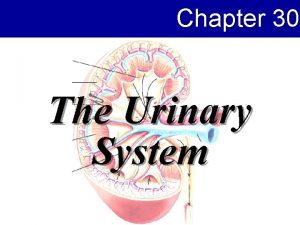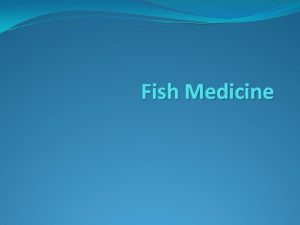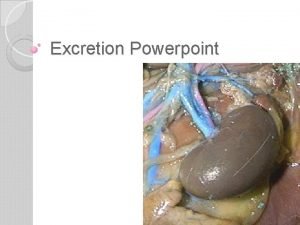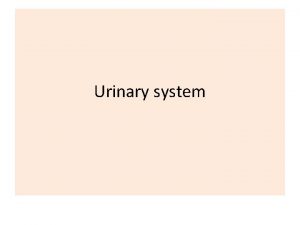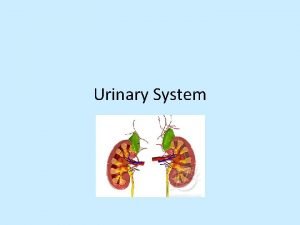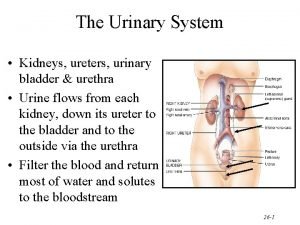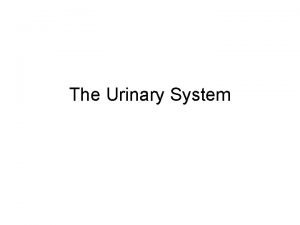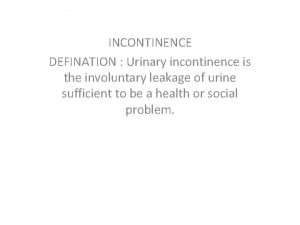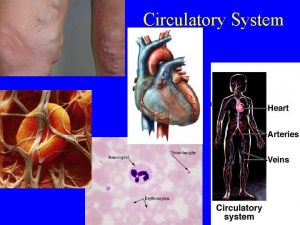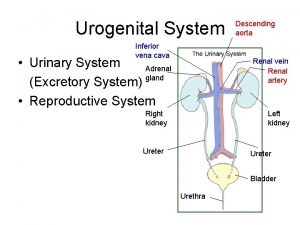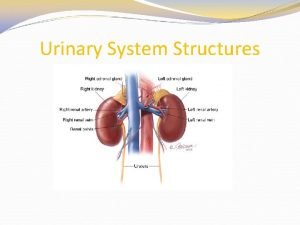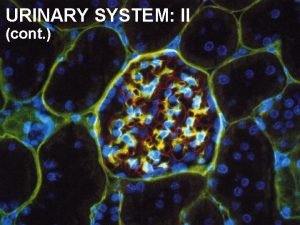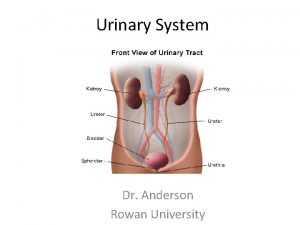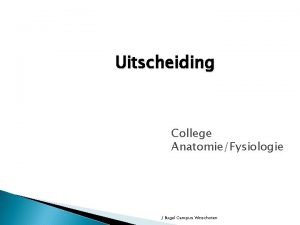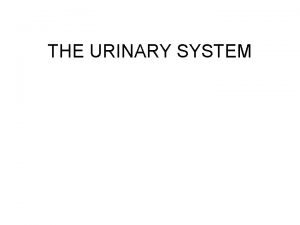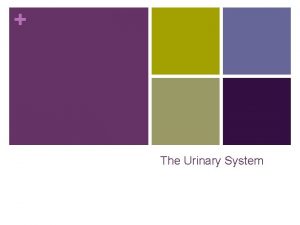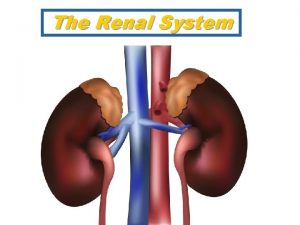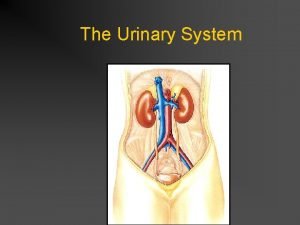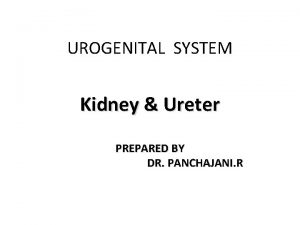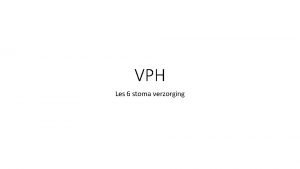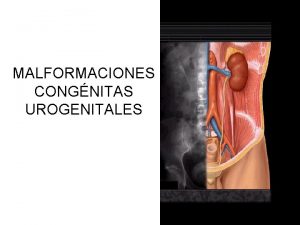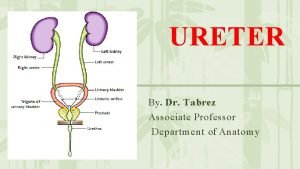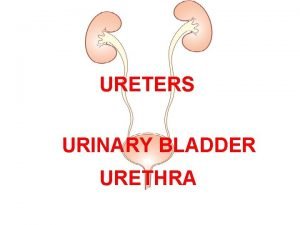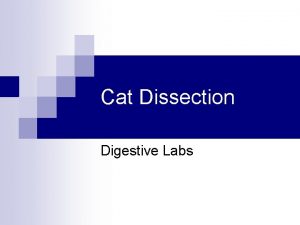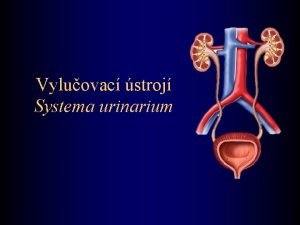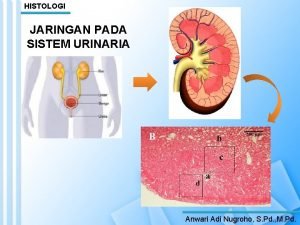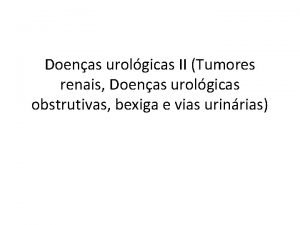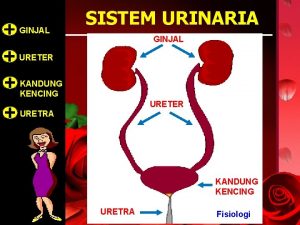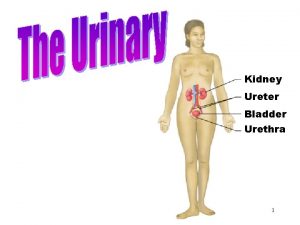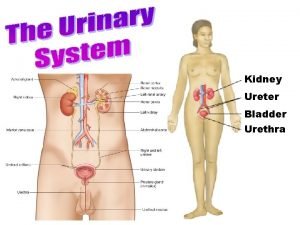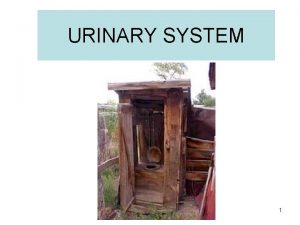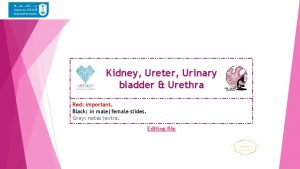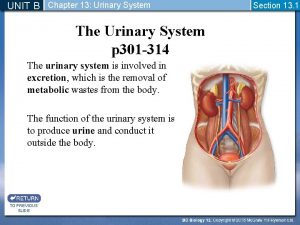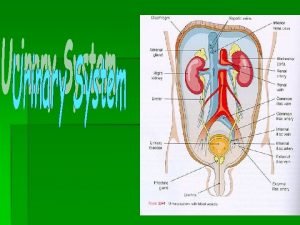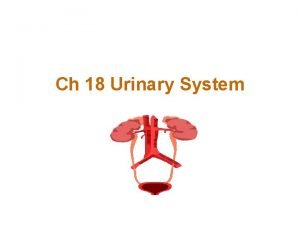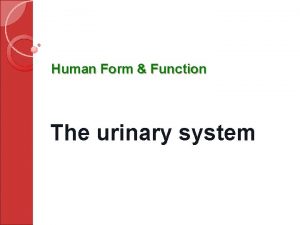Unit 7 The Urinary System Word Formation ureter
































































- Slides: 64

Unit 7 The Urinary System

Word Formation ( ureter, urethra ) ur/o- 尿 abdomin/o- 腹 ( abdomen ) ( urethritis, cystitis ) -itis 炎症 ( cystitis, cystoscopy ) cyst/o- 囊, 膀胱 pyel/o- 肾盂 ( pyelonephritis, pyelogram ) nephr/o- 肾 (nephron ) vagin/o- 阴道 ( vagina ) ( diaphragm ) dia- 通过; 区别, 分离 sperm/o- ( spermicidal, spermicide)

-cide 杀 ( spermicidal ) bio- 生, 生命 ( antibiotics ) anti- 抑制, 对抗, 防止 ( antibody ) micro- 小, 微, 细 ( microbe ) -gram 图, 照片 -scopy 检查(法) ( pyelogram, radiogram ) ( cystoscopy ) ( trimethoprim ) tri- 三 tetra- 四 ( tetracycline ) immun/o- 免疫 ( immunoglobulin )

Group Discussion n n What are the organs of urinary system ? Can you name a few urinary tract infections in English ?

Clinical and Pathological Conditions Cystitis----inflammation of the urinary bladder Nephritis----inflammation of the kidneys Glomerulonephritis ----nephritis accompanied by inflammation of the capillary loops in the glomerli of the kidney Prostatitis----inflammation of the prostate gland Pyelonephritis----inflammation of the kidney and its pelvis. Ureteritis----inflammation of a ureter Urethritis----inflammation of the urethra

Introduction The urinary system plays a most important role in maintaining the homeostasis by excreting waste materials through urine. It consists of two kidneys which filter the blood and secrete the urine, two ureters, which convey urine from the kidney to the urinary bladder, which receives and retains the urine, and a urethra, through which the urine is removed from the body.


The kidneys are a filter for the blood. The body has two kidneys located in the middle of the back at about the location of your elbows. Blood is pumped from the heart to the kidneys to be cleaned. Each kidney has about 1000, 000 nephrons that act as filters. As the blood goes into a nephron, everything that is dissolved in the blood ( waste products, food ) is pushed out of the blood into small tubules. As these things travel through the tubule, the water and anything else the body needs goes back into the blood.

The rest of the waste products keep moving through the tubule into the ureters. The ureter is the tube that leads to the bladder. The cleaned blood leaves the kidney and travels throughout the body. About 150 liters (33 gallons) of fluid pass through your kidneys every day. But 99% of this is cleaned and goes back into your blood. In their lifetimes, adults pass about 40, 000 liters (8, 800 gallons) of urine. This is enough to fill 500 bath tubs.


The bladder is where urine is stored to be released from the body. It can hold between one half to two cups of urine before it needs to be emptied. Everyday about two to five cups of urine pass through the bladder. The more water you drink, the more urine is produced. If it is hot outside and you produce a lot of sweat, you will not make as much urine.

About 96% of urine is water. It also contains some waste salts and a substance called urea. Urea( 尿素 ) is made during the breakdown of proteins in your liver. Urea may also leave your body in sweat. If urea builds up in your body, it is a sign that your kidneys are not working properly. Kidney failure can be fatal if it is not treated quickly.

A glomerulus is a capillary tuft surrounded by Bowman's capsule in nephrons of the vertebrate kidney. It receives its blood supply from an afferent arteriole of the renal circulation, and empties into an efferent arteriole. The resistance of the arterioles results in high pressure in the glomerulus aiding the process of ultrafiltration where fluids and soluble materials in the blood are forced out of the capillaries and into Bowman's capsule. The rate at which blood is filtered through the glomeruli is the glomerular filtration rate (GFR), measurements of which are often used to determine renal function.













Understanding the Text Para. 1 -2 Question: 1. What do the first two paragraphs try to tell us ? Difficult Points doctor visits----就诊,就医,看病(P 107) e. g. UTIs account for about 8. 3 million doctor visits each year. 每年有约 830万的患者因尿道感染就医。

More examples: 1) The patient is too weak to have any visits. 病人身体太弱不宜探视。 2) He is allowed visits of only ten minutes. 他只被允许十分钟的探视。 3)visiting times 探视时间

prone to / susceptible to / vulnerable to ----likely to suffer from 易于…的,有…倾向的 e. g. 1) Young people are especially prone to this disease. 2) Elderly women are more susceptible to osteoporosis and even fracture. 3) Premature babies are especially vulnerable to infection. 早产儿特别容易被感染。

Para. 3 Questions: 2. What are the organs of the urinary system ? 3. What are the functions of the kidneys ? Para. 4 pass----to allow (feces or urine) to come out of the body 1) He passed blood in his bowel movement. 他便血。 2) She had pains when she passed water. 她尿痛。

Para. 5 Question: 4. What characteristics does urine normally have ? Para. 6 Question: 5. What are three pathological conditions mentioned in this paragraph ? Para. 7 Question: 6. What kinds of bacteria can cause UTIs according to this paragraph ? Is there anything special about them ?

n Escherichia coli (E. coli), is one of many species of bacteria living in the lower intestines of mammals, known as gut flora. When located in the large intestine, it assists with waste processing, vitamin K production, and food absorption. Discovered in 1885 by Theodor Escherich, a German pediatrician and bacteriologist, E. coli are abundant: the number of individual E. coli bacteria in the feces that a human defecates in one day averages between 100 billion and 10 trillion.

E. coli can generally cause several intestinal and extra-intestinal infections such as: n urinary tract infections, n meningitis, n peritonitis, n mastitis, n septicemia n Gram-negative pneumonia

Low-temperature electron micrograph of a cluster of E. coli bacteria, magnified 10, 000 times. Each individual bacterium is oblong shaped.

Para. 8 Question: 7. What does this paragraph mainly talk about ? Difficult Points ward off----fend off; turn aside 挡开; 避免, 防止,抵御 e. g. 1) These herbs are said to ward off influenza. 2) Cold viruses can be warded off with a diet rich in vitamins and minerals. 2) Good hygiene can also ward off infection, which is why doctors recommend regular hand washing.

Para. 9 -13 Questions: 8. What kinds of people are usually more prone to UTIs ? 9. Why do women have more urinary infections than men ? ( para. 12 ) Difficult Points void---- vt. 排泄, 排空; 排尿(para. 10) trigger---- to cause, lead to (para. 12) e. g. For many women, sexual intercourse seems to trigger an infection. 对许多妇女,性交可能引发感染。

Catheter (para. 10 ) A hollow flexible tube for insertion into a body cavity, duct, or vessel to allow the passage of fluids or distend a passageway. Its uses include the drainage of urine from the bladder through the urethra or insertion through a blood vessel into the heart for diagnostic purposes.


Any catheter which is inserted into the bladder and allowed to remain in the bladder is called an indwelling catheter. A common type of indwelling catheter is a Foley catheter. A Foley catheter has a balloon attachment at one end. After the Foley catheter is inserted, the balloon is filled with sterile water. The filled balloon prevents the catheter from leaving the bladder.

n Foley Catheter, Stomach Tube, T-tube, etc.



An umbilical catheter is a long, soft plastic tube (usually made of silicone) that is placed in the umbilical cord either through the umbilical artery or umbilical vein to allow IV fluids and medications to be given over an extended period of time.


Para. 13 spermicidal foam----杀精泡沫 Para. 14 Question: 10. What are the common symptoms of UTIs in adults ? Para. 15 11. What are the common symptoms of UTIs in children ?

Para. 16 Question: 12. How to get a “clean catch” urine sample ?

n A "clean-catch" urine sample is performed by collecting the sample of urine in midstream. Men or boys should wipe clean the head of the penis. Women or girls need to wash the area between the lips of the vagina with soapy water and rinse well. A small amount of urine should initially fall into the toilet bowl before it is collected (this clears the urethra of contaminants). Then, in a clean container, catch about 1 to 2 ounces of urine and remove the container from the urine stream. The container is then given to the health care provider.

Difficult Points pus----yellow liquid composed of blood serum, pieces of dead tissue, white blood cells and the remains of bacteria, formed by the body in reaction to infection. 脓 py- or pyo- ----pus e. g. pyoderma 脓皮病 pyogenic 生脓的 genital----adj. referring to reproductive organs 生殖器的 e. g. genital herpes 生殖器疱疹 genital organs (genitals) 外生殖器 genitalia 生殖器

Para. 17 Questions: 13. What is urinalysis test ? 14. What is sensitivity test ? urinalysis ---- the analysis of urine, using physical, chemical and microscopical tests to determine the proportions of its normal constituents and to detect alcohol, drugs, sugar, or other abnormal constituents. sensitivity test ----A laboratory method for testing antibiotic effectiveness

Para. 18 urine culture ----A urine culture is a test that is done to see if there are bacteria (germs) that cause infection in the urine. A "clean catch" urine specimen (one that has no outside bacteria in it) is necessary for an accurate urine culture. In order for the specimen to be "clean, " careful cleansing of the area is important.

Difficult Points culture----n. bacteria or tissues grown in a laboratory 培养物; 培养基(culture medium) cultivate----v. e. g. Agar is used as a culture medium to cultivate bacteria in a laboratory. 在实验室琼脂被用做培 养细菌的培养基。

Para. 19. Question: 15. What is an intravenous pyelogram ? Difficult Points strain----group of microorganisms which are different from others of the same type 株 e. g. 1) a new strain of influenza virus 2)When an infection does not clear up with treatment and is traced to the same strain of bacteria, the doctor may order some tests to determine if your system is normal.

Para. 20 Question: 16. What tests may doctors suggest for recurrent infections? Difficult Points recurrent----adj. occurring again 复发的 e. g. recurrent abortion/ fever 习惯性流产/ 回归热 recurrence----n. 复发 e. g. He had a recurrence of a fever which he had caught in the tropics. recur----v. to return 复发 e. g. The headaches recurred frequently, but usually after the patient had eaten chocolate.

Para. 21 Question: 17. What are the common therapies for UTIs according to this paragraph? Difficult Points offending bacteria---- invading bacteria 入侵的细菌; 致病菌 offend----vt. 冒犯; 使不舒服 e. g. offending the ear/eye 刺耳/眼

Para. 22 Question: 18. For doctors, is there anything special in treating UTIs ? Difficult Points follow-up----check on a patient who has been examined before 随访; 复查 e. g. A follow-up urinalysis helps to confirm that the urinary tract is infection-free. 随访尿检帮助确认尿路感染是否治愈。

Para. 23 Question: 19. How to treat patients with kidney infections according to this paragraph ? Difficult Points hospitalize / hospitalization e. g. 1) 他病得很厉害必须马上住院。 He is so ill that he must be hospitalized immediately. 2) 医生建议马上住院。 The doctor recommended immediate hospitalization.

Para. 24 Question: 20. What advice do doctors have to prevent UTIs ? Do you have any other good ideas ?

n A heating pad is a pad used for warming of parts of the body in order to manage pain. Localized application of heat causes the blood vessels in that area to dilate, enhancing perfusion to the targeted tissue. Types of heating pads include electrical, chemical and hot water bottles.

Para. 25. Question: 21. Why do some women and children tend to get UTIs repeatedly according to the researchers ?

Difficult Points Vaccination 接种 ---- a means of producing immunity to a disease by using a vaccine, or a special preparation of antigenic material, to stimulate the formation of appropriate antibodies. Vaccine 疫苗 ----a special preparation of antigenic material that can be used to stimulate the development of antibodies and thus confer active immunity against a specific disease or number of diseases.

Para. 26 Question: 22. What is the main idea of the last paragraph ? Difficult Points suppository---a medicinal preparation in solid form suitable for insertion into the rectum or vagina. 栓剂 固体医学制剂, 适用于塞入直肠或阴道内。

Phrases in the Test 1. 2. 3. 4. 5. 6. 7. 8. 9. urinary tract infection reproductive system prostate gland spermicidal foam a frequent urge to urinate pubic bone a fullness in the rectum loose bowels intravenous pyelogram

10. offending bacteria 11. single-dose treatment 12. a follow-up urinalysis 13. injected and oral vaccines 14. change in urinary pattern

Dialogue Parent: My baby ran a high temperature suddenly last night and cried all night. Doctor: Is there anything else unusual ? Parent: She cries each time she passes water. Doctor: Does she urinate more often than usual ? Parent: Yes, very often. Doctor: What color is the urine ? Parent: It’s cloudy. Doctor: Please give us a specimen of her urine for examination right now.

Parent: Here’s the result. Is it normal ? Doctor: No, it’s not. Has she been ill like this before ? Parent: No. This is the first time. Doctor: I think she is suffering from a urinary tract infection. Parent: Will she be all right ? Doctor: Yes, there’s nothing to worry about. Give her the medicine regularly and see that she drinks plenty of fluids. Bring her back here in one week.
 Spleen function
Spleen function Hoover word
Hoover word Word formation processes and examples
Word formation processes and examples Unit 4 nouns articles word formation
Unit 4 nouns articles word formation Introduction of urinary system
Introduction of urinary system Figure 15-3 is a diagram of the nephron
Figure 15-3 is a diagram of the nephron Pylo medical term
Pylo medical term Intugementary
Intugementary Fetal pig urinary system labeled
Fetal pig urinary system labeled Chapter 30 the urinary system
Chapter 30 the urinary system Chapter 15 the urinary system figure 15-3
Chapter 15 the urinary system figure 15-3 Chapter 20 urinary/excretory system
Chapter 20 urinary/excretory system Urinary system model
Urinary system model Urinary system fun fact
Urinary system fun fact Osteichthyes
Osteichthyes Urinary system powerpoint
Urinary system powerpoint Proximal convoluted tubule histology
Proximal convoluted tubule histology Function of antidiuretic hormone
Function of antidiuretic hormone Nephron urinary system
Nephron urinary system Abnormal constituents of urine
Abnormal constituents of urine Hysterosalpingography
Hysterosalpingography Defination of urine
Defination of urine Urinary system label
Urinary system label Rat external anatomy
Rat external anatomy Rat urinary system
Rat urinary system Vena cava urinary system
Vena cava urinary system Figure 15-3 is a diagram of the nephron
Figure 15-3 is a diagram of the nephron Juxtaglomerular cells vs macula densa
Juxtaglomerular cells vs macula densa Bowmans capsule
Bowmans capsule Urinary system
Urinary system Composition of urine slideshare
Composition of urine slideshare Cortical nephron
Cortical nephron Normal and abnormal constituents of urine
Normal and abnormal constituents of urine Urinary system
Urinary system Location of kidneys in humans
Location of kidneys in humans Lith medical term
Lith medical term Renal lobe and lobule
Renal lobe and lobule Urinary system
Urinary system Youtube urinary system
Youtube urinary system The urinary system chapter 15
The urinary system chapter 15 Anatomical structure of urinary system
Anatomical structure of urinary system Chapter 9 the urinary system labeling exercises
Chapter 9 the urinary system labeling exercises Chapter 25 the urinary system
Chapter 25 the urinary system Formation initiale vs formation continue
Formation initiale vs formation continue Ureter meatus
Ureter meatus Basinlike area of the kidney continuous with the ureter
Basinlike area of the kidney continuous with the ureter Margo lateralis renalis
Margo lateralis renalis Calyx major
Calyx major Ureter praeternaturalis
Ureter praeternaturalis Golf hole ureter tb
Golf hole ureter tb Mezonefrik kanaldan gelişen yapılar
Mezonefrik kanaldan gelişen yapılar Poliquistosis renal
Poliquistosis renal Narrowings of the ureter
Narrowings of the ureter Ureter and fallopian tube
Ureter and fallopian tube Hyperparathyreosis
Hyperparathyreosis Ureteral blood supply
Ureteral blood supply Kanalikulus
Kanalikulus Golf hole ureter
Golf hole ureter Chords
Chords Falciform ligament cat
Falciform ligament cat Systema urinarium
Systema urinarium Blue glaucus anatomy
Blue glaucus anatomy Simple columnar epithelial
Simple columnar epithelial Histologi sistem urinaria
Histologi sistem urinaria Ureter
Ureter









